Castle Hill Cider
by
Kathy Sullivan
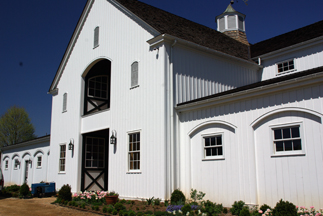
Summary: Castle Hill Cider is located on the Castle Hill estate, an historical landmark near Charlottesville, Virginia. The cidery is also a beautiful spot for a wedding. Enjoy ciders and views of Virginia’s stunning countryside.
At the end of February we made a return visit to Castle Hill Cider where years earlier we had seen our first qvevri buried in the ground. Our first visit was just as the owners were finishing the renovations. Even then we knew it was going to be a gem for visitors to find. Our recent visit proved us to be correct.
Castle Hill Cider is located on a 600-acre estate. The Castle Hill estate is on the Virginia Landmark Registry and the National Register of Historic Places. A large barn was built on the property in 1998 for use as a cattle auction barn.
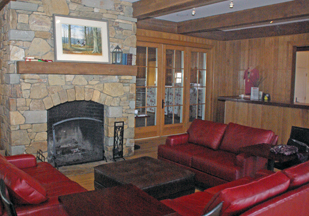 Today Stuart Madany is the production manager. Stuart has done his research into the long history of cider. The tasting room is fully finished and tastefully decorated with comfortble red leather seating near the large stone fireplace. The tasting counter is mahogany and the walls are paneled with oak. Views of the cider production area can be seen from tasting room.
Today Stuart Madany is the production manager. Stuart has done his research into the long history of cider. The tasting room is fully finished and tastefully decorated with comfortble red leather seating near the large stone fireplace. The tasting counter is mahogany and the walls are paneled with oak. Views of the cider production area can be seen from tasting room.
The production area has a built-in stage for special events. Overhead the balcony provides an overview of the production room and event area. A balcony off the second floor offers views of the country setting. A patio with tables and chairs is adjacent to the first floor tasting room. Stunning views of the property are available from both event areas.
Crafting Cider
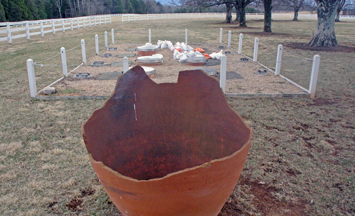 At Castle Hill, cider is produced with two different types of fermentation vessels. Stuart ferments cider in stainless steel tanks and in old style qvevri. The qvevris were made in the country of Georgia, a country known as the birthplace of wine. Research has shown that for thousands of years qvevris were buried in the ground, and wine was fermented in them.
At Castle Hill, cider is produced with two different types of fermentation vessels. Stuart ferments cider in stainless steel tanks and in old style qvevri. The qvevris were made in the country of Georgia, a country known as the birthplace of wine. Research has shown that for thousands of years qvevris were buried in the ground, and wine was fermented in them.
Today Castle Hill Cider uses this old winemaking technique for producing cider. Castle Hill is forging a trail for cider makers with the use of qvevris for fermentation. Several different sized qvevris are buried below the surface of the soil.
The adjacent photo shows the remains of a qvevri broken during transportation; it now stands guard over the marani. Other pieces of the broken qvevri are in the tasting room. Staff use the broken pieces to show visitors the wax lining on the inside of the terra cotta qvevri. Each of the qvevris buried outdoors is sealed with a locked metal cover – a requirement of OSHA. The second qvevri photo shows the bottom of a qvevri. The qvevri was also signed and dated by the producer, a practice used by all qvevri producers in Georgia.
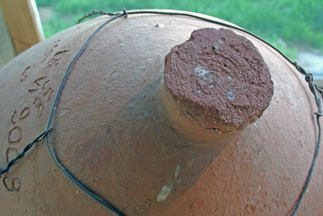 As we spoke with Stuart about using qvevris for making cider he noted that he had first become interested in qvevri because of his architectural interest in healing and how shape and material affects people. In studying these ideas he was introduced to Viktor Schauberger’s intriguing concepts.
As we spoke with Stuart about using qvevris for making cider he noted that he had first become interested in qvevri because of his architectural interest in healing and how shape and material affects people. In studying these ideas he was introduced to Viktor Schauberger’s intriguing concepts.
Viktor recognized that nature uses egg shapes. The ancients knew about storing food in amphorae that is somewhat egg shaped. Amphorae are similar to qvevris but not the same. Amphorae are earthen vessels used for transport. Stuart read about how wineries were producing wine and it reminded him of Viktor’s egg theory.
Two of the names of the ciders are from science concepts including Sir Isaac Newton’s study of gravity and Viktor Schauberger’s study of levity. The idea of using Gravity as a label was prompted by Newton’s visit to his mother’s apple orchard and watching an apple fall. Terrestrial and Celestial are concepts regarding the earth and sun.
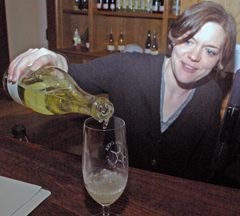 Cider Tasting
Cider Tasting
The cidery has an orchard with almost 30 apple varieties. In the tasting room elegant Schott Zwiesel wine glasses are used for tastings. Cheese plates are available for purchase and include an Albemarle Baking Company baguette. All of the ciders we tasted ranged from 7.1 to 8.6 percent alcohol.
The first cider we tasted was Terrestrial, produced from Winesap and Pippin apple varieties. The Terrestrial was very appley perhaps due to the Winesap apple variety used in this cider blend.
The Levity cider we tasted was produced in qvevri. Levity was made with the Pippin apple variety. Commercial yeast was used in making this cider. The wine was a light yellow. With a floral aroma the taste was of apple with a hint of honey – perhaps the hint of honey was due to the beeswax coating that has been applied to the qvevri every year. The finish had some minerality on the aftertaste. The cider spent four months in qvevri. Stuart is pleased with the first qvevri cider he has made and will continue producing qvevri ciders. Currently he has several ciders in qvevris resting in the red clay qvevris firmly buried in the ground.
Celestial Merret was a blend of Winesap, Pippin and several other apple varieties. Apple nuances were throughout the cider. The taste also had hints of bread. Celestial was made with mostly Pippin apples and a touch of Winesap. The cider had apple notes throughout. Gravity was a still wine. The straw color wine offered an aroma of apple and floral notes. The taste was of apple and floral with hints of citrus. The finish had apple notes with hints of peach and citrus on the aftertaste.
When visiting historic Charlottesville, set aside time for a visit to Castle Hill Cider.
Castle Hill Cider
6065 Turkey Sag Road
Keswick, VA 22947
GPS: N38º 05.321' W78º 17.441'
Visit these Virginia wineries and wine tour groups that partner with Wine Trail Traveler.




